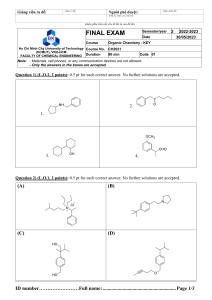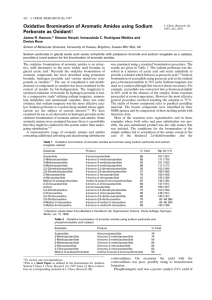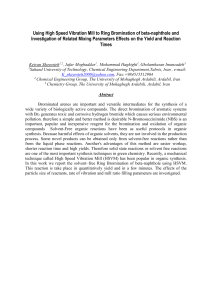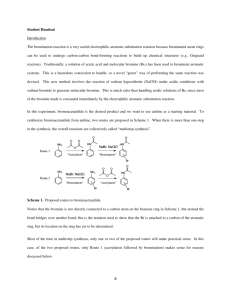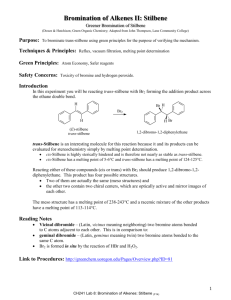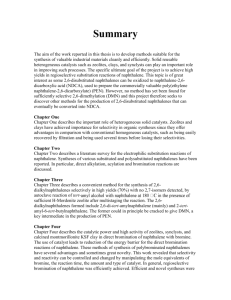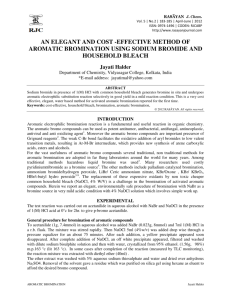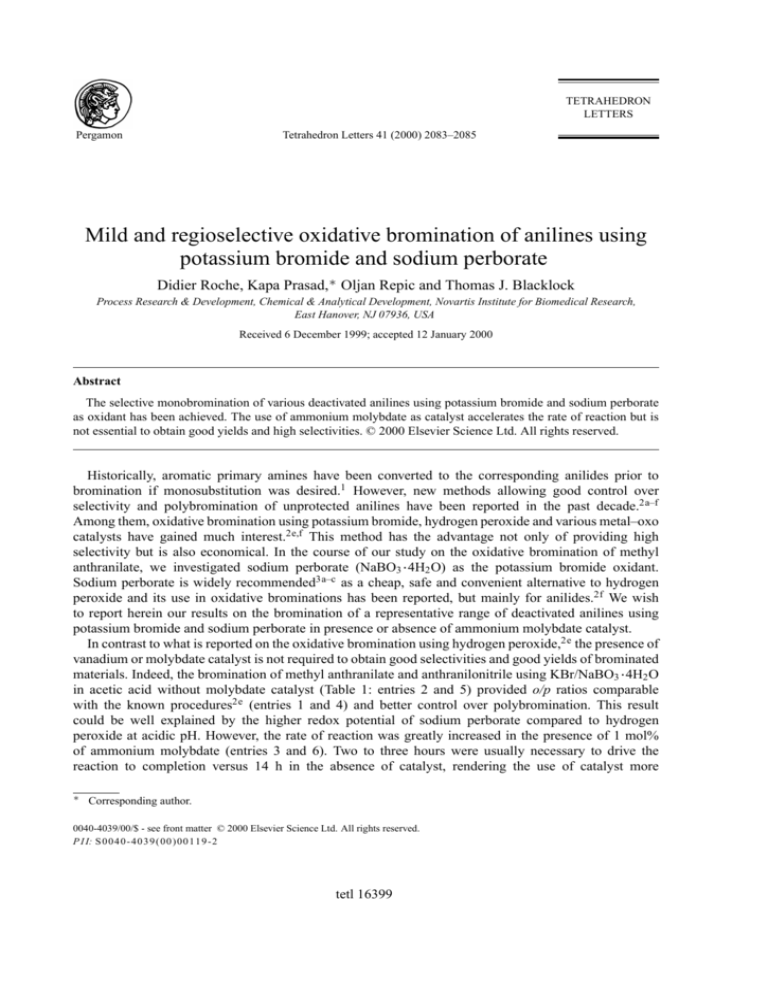
TETRAHEDRON
LETTERS
Pergamon
Tetrahedron Letters 41 (2000) 2083–2085
Mild and regioselective oxidative bromination of anilines using
potassium bromide and sodium perborate
Didier Roche, Kapa Prasad,∗ Oljan Repic and Thomas J. Blacklock
Process Research & Development, Chemical & Analytical Development, Novartis Institute for Biomedical Research,
East Hanover, NJ 07936, USA
Received 6 December 1999; accepted 12 January 2000
Abstract
The selective monobromination of various deactivated anilines using potassium bromide and sodium perborate
as oxidant has been achieved. The use of ammonium molybdate as catalyst accelerates the rate of reaction but is
not essential to obtain good yields and high selectivities. © 2000 Elsevier Science Ltd. All rights reserved.
Historically, aromatic primary amines have been converted to the corresponding anilides prior to
bromination if monosubstitution was desired.1 However, new methods allowing good control over
selectivity and polybromination of unprotected anilines have been reported in the past decade.2a–f
Among them, oxidative bromination using potassium bromide, hydrogen peroxide and various metal–oxo
catalysts have gained much interest.2e,f This method has the advantage not only of providing high
selectivity but is also economical. In the course of our study on the oxidative bromination of methyl
anthranilate, we investigated sodium perborate (NaBO3 ·4H2 O) as the potassium bromide oxidant.
Sodium perborate is widely recommended3a–c as a cheap, safe and convenient alternative to hydrogen
peroxide and its use in oxidative brominations has been reported, but mainly for anilides.2f We wish
to report herein our results on the bromination of a representative range of deactivated anilines using
potassium bromide and sodium perborate in presence or absence of ammonium molybdate catalyst.
In contrast to what is reported on the oxidative bromination using hydrogen peroxide,2e the presence of
vanadium or molybdate catalyst is not required to obtain good selectivities and good yields of brominated
materials. Indeed, the bromination of methyl anthranilate and anthranilonitrile using KBr/NaBO3 ·4H2 O
in acetic acid without molybdate catalyst (Table 1: entries 2 and 5) provided o/p ratios comparable
with the known procedures2e (entries 1 and 4) and better control over polybromination. This result
could be well explained by the higher redox potential of sodium perborate compared to hydrogen
peroxide at acidic pH. However, the rate of reaction was greatly increased in the presence of 1 mol%
of ammonium molybdate (entries 3 and 6). Two to three hours were usually necessary to drive the
reaction to completion versus 14 h in the absence of catalyst, rendering the use of catalyst more
∗
Corresponding author.
0040-4039/00/$ - see front matter © 2000 Elsevier Science Ltd. All rights reserved.
P I I: S0040-4039(00)00119-2
tetl 16399
2084
appealing. 20 -Aminoacetophenone was as well brominated with high para selectivity (94.2% para) in
the presence (entry 8) or absence (entry 7) of catalyst. It is worth noting that although sodium perborate
in AcOH has been used as a reagent to promote Baeyer–Villiger reactions at room temperature,4 ketones
are compatible with the reaction conditions. Acid functionalities are compatible as well (entry 20),
although bromination of anthranilic acid led to a moderate yield (entry 9). Excellent results were
obtained with ortho-halogenated anilines (entries 10–13) which are attractive intermediates in organic
synthesis.5 However, bromination of the strongly deactivated ortho-nitroaniline gave a mixture of mono
and polybrominated compounds. Our method was extended to the bromination of para-substituted
anilines (entries 15–20) which gave ortho-brominated compounds with good to excellent control over
dibromination.
Table 1
Regioselective mono bromination of anilines
In a typical experiment, NaBO3 ·4H2 O (9.3 mmol) was added at once to a suspension of KBr (10.1
mmol), anthranilonitrile (8.5 mmol) and ammonium molybdate (0.08 mmol) in AcOH (10 mL) at rt.
2085
After stirring for 3 h, the reaction was quenched with a saturated solution of Na2 CO3 and extracted
with EtOAc. The organic extract was washed with a saturated solution of Na2 CO3 , dried over MgSO4 ,
filtered and concentrated to give 5-bromoanthranilonitrile (1.65 g, 98% yield, 98% para). Alternatively,
the reaction was quenched with ice water. The resulting suspension was filtered, the white precipitate
thoroughly washed with water and dried under vacuum at 40°C to give 5-bromoanthranilonitrile (1.5 g,
90% yield, 100% para).
In conclusion, we have developed a practical method using sodium perborate as an interesting alternative to hydrogen peroxide in the oxidative bromination of unprotected aromatic amines. Brominated
anilines are obtained in good to excellent yields, and several chemical functionalities are compatible with
the reaction conditions.
Acknowledgements
The authors thank Dr. Tao He (Novartis) for his expertise in mass spectroscopy.
References
1. March, J. Advanced Organic Chemistry; 3rd ed., Wiley: New York, 1985; pp. 476–479.
2. (a) Berthelot, J.; Guette, C.; Essayegh, M.; Desbene, P. L.; Basselier, J. J. Synth. Com. 1986, 16, 1641–1645; (b) Olah, G.
A.; Ohannesian, L.; Arvanaghi, M. Synthesis 1986, 868–870; (c) Gervat, S.; Leonel, E.; Barraud, J. Y.; Ratovelomanana, V.
Tetrahedron Lett. 1993, 34, 2115–2118; (d) Paul, V.; Sudalai, A.; Daniel, T.; Srinivasan, K. V. Tetrahedron Lett. 1994, 38,
7055–7056; (e) Choudary, B. M.; Sudha, Y.; Reddy, P. N. Synlett 1994, 450; (f) Hanson, J. R.; Harpel, S.; Rodriguez Medina,
I. C.; Rose, D. J. Chem. Res. 1997, 432–433.
3. (a) Paquette, L. A. Encyclopedia of Reagents for Organic Synthesis; Wiley: New York, 1995; Vol. 7, pp. 4611–4613; (b)
McKillop, A.; Sanderson, W. R. Tetrahedron 1995, 51, 6145–6166; (c) Muzart, J. Synthesis 1995, 1325–1346.
4. Mc Killop, A.; Tarbin, J. A Tetrahedron 1987, 43, 1753–1758.
5. 4-Bromo-2-iodoanilines are common intermediates in the synthesis of indoles: Ezquerra, J.; Pedregal, C.; Lamas, C. J. Org.
Chem. 1996, 61, 5804–5812 and references cited therein.

